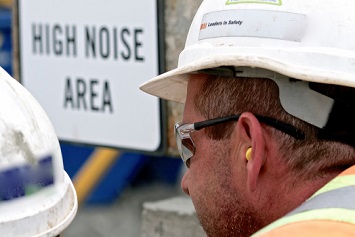Hearing loss is a common disability, affecting about 48 million people in the United States. The impacts of hearing loss on the workforce are far-reaching, and can result in lost productivity, lower wages, and increased safety risks.
While you might think it only affects older employees, about 60% of those with hearing loss are below retirement age. And 20% of kids between the ages of 12 and 19 already have some degree of hearing loss, meaning the workplace will only see more employees with difficulty hearing. As this condition becomes more prevalent, it is imperative that employers understand what they can do to maintain a safe environment, ensure compliance, and prevent more employees from losing their hearing on the job.
Hearing Loss and Safety
Employees with hearing loss can find it challenging to follow directions from their supervisor or communicate with colleagues, which might impede their ability to perform work tasks correctly. As a result, mistakes can be made. But it’s not just about communications. In manufacturing facilities or any workplace involving heavy machinery, power tools, or vehicles, an audible alert is often the first indicator that something isn’t right. If employees are unable to hear warning sounds, the danger to them and others increases.
A less obvious yet still important issue of hearing loss at work is the social aspect. If it’s difficult for employees to hear and participate in conversations with colleagues during lunch or on breaks, they can feel excluded, demoralized, and depressed. This emotional fallout could have a negative effect on their performance and engagement.
Financial Impact of Hearing Loss
Studies show that employees with hearing loss earn significantly less income over the course of their careers than their hearing colleagues, creating a differential of more than $14,000 per year, depending on the severity of the hearing loss. The potential loss of income extends to the employer, as well. When employees are unable to work effectively due to hearing loss, or feel demoralized because of it, their productivity may decline and, thus, affect the company’s performance overall. If an incident occurs due to an employee missing a cue that something isn’t right, the company could expose itself to legal risk and the resulting financial burden.
Accommodating Employees with Hearing Loss
Despite these concerns, individuals with hearing loss should still be hired and given the same opportunities as other employees. The Americans with Disabilities Act (ADA) makes it illegal to discriminate against employees who are deaf or have hearing loss. Besides, individuals who have faced challenges in life due to their hearing can add great value to your organization by drawing on their experiences to come up with novel solutions to problems. They might simply need some reasonable accommodations to make sure they can work productively and safely. Possible reasonable accommodations include:
- Assigning the employee to a workstation in a quiet part of the office;
- Providing assistive technology to help him or her communicate, such as a voice-to-text phone system;
- Adjusting the position or delegating certain responsibilities to others if good hearing is essential to a particular job; and
- Finding out the best way to communicate with the employee, e.g., whether he or she hears better on one side than the other, prefers face-to-face meetings over phone calls, or whatever else you can do to make his or her work experience a better one.
Preventing Hearing Loss on the Job
Given the effects of hearing loss—and considering that 22 million workers are exposed to potentially damaging noise levels on the job each year—employers should play a lead role in helping their employees protect their hearing.
For workplaces in which employees are regularly exposed to decibel (dB) levels of 85 dB or higher, employers are required by the Occupational Safety and Health Administration (OSHA) to provide proper ear protection in the form of ear plugs or earmuffs. But companies can go further to actively reduce the risk of noise-induced hearing loss. According to OSHA, here are some other ways to prevent hearing loss:
- Select tools and machinery with low noise levels.
- Ensure machinery is maintained and well-lubricated.
- Place barriers between the source of noise and employees by way of sound walls or curtains.
- Put firm guidelines around how much time an employee spends at a noise source.
- Operate loud machines during shifts when fewer employees are exposed.
- Create a quiet room where employees can enjoy some silent time to relax and recharge away from the noise of the workplace.
Even if your workplace doesn’t include heavy machinery, there are still some risks to employees’ hearing in an office environment. Typical office noises like ringing phones, printers, and conversations between colleagues can be distracting and lead employees to listen to music via earbuds or headphones all day. Listening to music at loud volumes for long periods can cause hearing loss, and this is one of the reasons it’s on the rise among young people. Providing guidance to employees on how they can protect their hearing (e.g., listening to music at 60% volume or lower for less than an hour and a half a day) can help reduce the risk of developing hearing loss in the first place.
Other things companies can do to decrease the noise and, thus, lower the need for employees to blast music include:
- Eliminating open-concept floor plans in favor of higher cubical walls to block out noise
- Adding sound-absorbing panels to the walls and ceiling
- Installing soundproof insulation if the office is on a busy road
Helping Employees Manage Their Hearing Health
Given the role that hearing plays in maintaining a safe workplace and employee productivity, employers should take the lead in encouraging workers not only to prevent hearing loss but also to seek treatment if it’s already present. The following are several examples of how employers can support their employees’ hearing health:
- Include hearing health in the company wellness plan.
- Invite a hearing care professional into the workplace to conduct hearing screenings.
- Recommend hearing care professionals nearby who can evaluate workers’ hearing and determine if hearing aids or other treatments are needed.
- Provide educational documents about hearing loss and what employees can do to protect their hearing at work and at home.
Creating a Safe, Productive Environment for Employees with Hearing Loss
As hearing loss becomes much more prevalent in the workforce, it’s imperative that employers be proactive in creating a workplace that is not only accommodating but also committed to maintaining employee safety. Following the above tips can equip you with the tools to provide a safe environment in which all employees can do their best work and are confident that their hearing will be protected.
| Rebecca Herbig, AuD, is Manager and Editor of Scientific Marketing for Sivantos USA, creator of Signia hearing aids. She previously spent 5 years with Sivantos (then Siemens Audiology Solutions) in Germany and before that worked as a clinical audiologist in northern Virginia. Rebecca earned her BS in Audiology from the University of Texas in Dallas and an AuD from Gallaudet University in Washington, D.C.
You can reach Rebecca at rebecca.herbig@signiausa.com and on LinkedIn; catch up with Signia on LinkedIn, Facebook, Twitter, and Instagram. |


